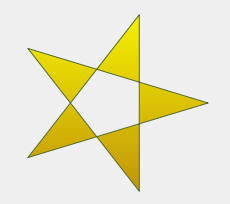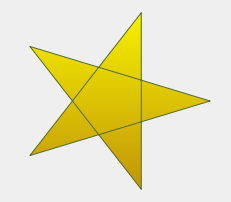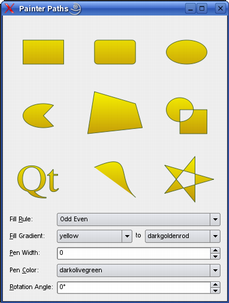QPainterPath¶
- PyQt5.QtGui.QPainterPath
Description¶
The QPainterPath class provides a container for painting operations, enabling graphical shapes to be constructed and reused.
A painter path is an object composed of a number of graphical building blocks, such as rectangles, ellipses, lines, and curves. Building blocks can be joined in closed subpaths, for example as a rectangle or an ellipse. A closed path has coinciding start and end points. Or they can exist independently as unclosed subpaths, such as lines and curves.
A QPainterPath object can be used for filling, outlining, and clipping. To generate fillable outlines for a given painter path, use the QPainterPathStroker class. The main advantage of painter paths over normal drawing operations is that complex shapes only need to be created once; then they can be drawn many times using only calls to the drawPath() function.
QPainterPath provides a collection of functions that can be used to obtain information about the path and its elements. In addition it is possible to reverse the order of the elements using the toReversed() function. There are also several functions to convert this painter path object into a polygon representation.
Composing a QPainterPath¶
A QPainterPath object can be constructed as an empty path, with a given start point, or as a copy of another QPainterPath object. Once created, lines and curves can be added to the path using the lineTo(), arcTo(), cubicTo() and quadTo() functions. The lines and curves stretch from the currentPosition() to the position passed as argument.
The currentPosition() of the QPainterPath object is always the end position of the last subpath that was added (or the initial start point). Use the moveTo() function to move the currentPosition() without adding a component. The moveTo() function implicitly starts a new subpath, and closes the previous one. Another way of starting a new subpath is to call the closeSubpath() function which closes the current path by adding a line from the currentPosition() back to the path’s start position. Note that the new path will have (0, 0) as its initial currentPosition().
QPainterPath class also provides several convenience functions to add closed subpaths to a painter path: addEllipse(), addPath(), addRect(), addRegion() and addText(). The addPolygon() function adds an unclosed subpath. In fact, these functions are all collections of moveTo(), lineTo() and cubicTo() operations.
In addition, a path can be added to the current path using the connectPath() function. But note that this function will connect the last element of the current path to the first element of given one by adding a line.
Below is a code snippet that shows how a QPainterPath object can be used:
|
# QPainterPath path;
# path.addRect(20, 20, 60, 60);
# path.moveTo(0, 0);
# path.cubicTo(99, 0, 50, 50, 99, 99);
# path.cubicTo(0, 99, 50, 50, 0, 0);
# QPainter painter(this);
# painter.fillRect(0, 0, 100, 100, Qt::white);
# painter.setPen(QPen(QColor(79, 106, 25), 1, Qt::SolidLine,
# Qt::FlatCap, Qt::MiterJoin));
# painter.setBrush(QColor(122, 163, 39));
# painter.drawPath(path);
|
The painter path is initially empty when constructed. We first add a rectangle, which is a closed subpath. Then we add two bezier curves which together form a closed subpath even though they are not closed individually. Finally we draw the entire path. The path is filled using the default fill rule, OddEvenFill. Qt provides two methods for filling paths:
|
|
See the FillRule documentation for the definition of the rules. A painter path’s currently set fill rule can be retrieved using the fillRule() function, and altered using the setFillRule() function.
QPainterPath Information¶
The QPainterPath class provides a collection of functions that returns information about the path and its elements.
The currentPosition() function returns the end point of the last subpath that was added (or the initial start point). The elementAt() function can be used to retrieve the various subpath elements, the number of elements can be retrieved using the elementCount() function, and the isEmpty() function tells whether this QPainterPath object contains any elements at all.
The controlPointRect() function returns the rectangle containing all the points and control points in this path. This function is significantly faster to compute than the exact boundingRect() which returns the bounding rectangle of this painter path with floating point precision.
Finally, QPainterPath provides the contains() function which can be used to determine whether a given point or rectangle is inside the path, and the intersects() function which determines if any of the points inside a given rectangle also are inside this path.
QPainterPath Conversion¶
For compatibility reasons, it might be required to simplify the representation of a painter path: QPainterPath provides the toFillPolygon(), toFillPolygons() and toSubpathPolygons() functions which convert the painter path into a polygon. The toFillPolygon() returns the painter path as one single polygon, while the two latter functions return a list of polygons.
The toFillPolygons() and toSubpathPolygons() functions are provided because it is usually faster to draw several small polygons than to draw one large polygon, even though the total number of points drawn is the same. The difference between the two is the number of polygons they return: The toSubpathPolygons() creates one polygon for each subpath regardless of intersecting subpaths (i.e. overlapping bounding rectangles), while the toFillPolygons() functions creates only one polygon for overlapping subpaths.
The toFillPolygon() and toFillPolygons() functions first convert all the subpaths to polygons, then uses a rewinding technique to make sure that overlapping subpaths can be filled using the correct fill rule. Note that rewinding inserts additional lines in the polygon so the outline of the fill polygon does not match the outline of the path.
Examples¶
Qt provides the Painter Paths Example and the Vector Deformation example which are located in Qt’s example directory.
The Painter Paths Example shows how painter paths can be used to build complex shapes for rendering and lets the user experiment with the filling and stroking. The Vector Deformation Example shows how to use QPainterPath to draw text.
|
|
See also
QPainterPathStroker, QPainter, QRegion, Painter Paths Example.
Enums¶
- ElementType
This enum describes the types of elements used to connect vertices in subpaths.
Note that elements added as closed subpaths using the addEllipse(), addPath(), addPolygon(), addRect(), addRegion() and addText() convenience functions, is actually added to the path as a collection of separate elements using the moveTo(), lineTo() and cubicTo() functions.
See also
Member
Value
Description
CurveToDataElement 3
The extra data required to describe a curve in a element.
CurveToElement 2
LineToElement 1
A line. See also lineTo().
MoveToElement 0
A new subpath. See also moveTo().
Methods¶
- __init__()
TODO
- __init__(QPainterPath)
TODO
- __add__(QPainterPath) → QPainterPath
TODO
- addEllipse(QRectF)
TODO
- addEllipse(float, float, float, float)
TODO
- addPath(QPainterPath)
TODO
- addPolygon(QPolygonF)
TODO
- addRect(QRectF)
TODO
- addRect(float, float, float, float)
TODO
- addRegion(QRegion)
TODO
- addRoundedRect(QRectF, float, float, mode: SizeMode = AbsoluteSize)
Adds the given rectangle rect with rounded corners to the path.
The xRadius and yRadius arguments specify the radii of the ellipses defining the corners of the rounded rectangle. When mode is RelativeSize, xRadius and yRadius are specified in percentage of half the rectangle’s width and height respectively, and should be in the range 0.0 to 100.0.
See also
- addRoundedRect(float, float, float, float, float, float, mode: SizeMode = AbsoluteSize)
TODO
- addText(float, float, QFont, str)
TODO
- __and__(QPainterPath) → QPainterPath
TODO
- angleAtPercent(float) → float
Returns the angle of the path tangent at the percentage t. The argument t has to be between 0 and 1.
Positive values for the angles mean counter-clockwise while negative values mean the clockwise direction. Zero degrees is at the 3 o’clock position.
Note that similarly to the other percent methods, the percentage measurement is not linear with regards to the length if curves are present in the path. When curves are present the percentage argument is mapped to the t parameter of the Bezier equations.
- arcMoveTo(QRectF, float)
TODO
- arcMoveTo(float, float, float, float, float)
TODO
- arcTo(QRectF, float, float)
TODO
- arcTo(float, float, float, float, float, float)
TODO
- boundingRect() → QRectF
TODO
- capacity() → int
TODO
- clear()
TODO
- closeSubpath()
TODO
- connectPath(QPainterPath)
TODO
- contains(QRectF) → bool
TODO
- contains(QPainterPath) → bool
Returns
trueif the given path p is contained within the current path. Returnsfalseif any edges of the current path and p intersect.Set operations on paths will treat the paths as areas. Non-closed paths will be treated as implicitly closed.
See also
- controlPointRect() → QRectF
TODO
- cubicTo(float, float, float, float, float, float)
TODO
- currentPosition() → QPointF
TODO
- elementAt(int) → Element
TODO
- elementCount() → int
TODO
- __eq__(QPainterPath) → bool
TODO
- fillRule() → FillRule
See also
- __iadd__(QPainterPath) → QPainterPath
TODO
- __iand__(QPainterPath) → QPainterPath
TODO
- intersected(QPainterPath) → QPainterPath
Returns a path which is the intersection of this path’s fill area and p’s fill area. Bezier curves may be flattened to line segments due to numerical instability of doing bezier curve intersections.
- intersects(QRectF) → bool
TODO
- intersects(QPainterPath) → bool
Returns
trueif the current path intersects at any point the given path p. Also returnstrueif the current path contains or is contained by any part of p.Set operations on paths will treat the paths as areas. Non-closed paths will be treated as implicitly closed.
See also
- __ior__(QPainterPath) → QPainterPath
TODO
- isEmpty() → bool
TODO
- __isub__(QPainterPath) → QPainterPath
TODO
- length() → float
Returns the length of the current path.
- lineTo(float, float)
TODO
- moveTo(float, float)
TODO
- __mul__(QTransform) → QPainterPath
TODO
- __ne__(QPainterPath) → bool
TODO
- __or__(QPainterPath) → QPainterPath
TODO
- percentAtLength(float) → float
Returns percentage of the whole path at the specified length len.
Note that similarly to other percent methods, the percentage measurement is not linear with regards to the length, if curves are present in the path. When curves are present the percentage argument is mapped to the t parameter of the Bezier equations.
- pointAtPercent(float) → QPointF
Returns the point at at the percentage t of the current path. The argument t has to be between 0 and 1.
Note that similarly to other percent methods, the percentage measurement is not linear with regards to the length, if curves are present in the path. When curves are present the percentage argument is mapped to the t parameter of the Bezier equations.
- quadTo(float, float, float, float)
TODO
- reserve(int)
TODO
- setElementPositionAt(int, float, float)
TODO
- setFillRule(FillRule)
See also
- simplified() → QPainterPath
Returns a simplified version of this path. This implies merging all subpaths that intersect, and returning a path containing no intersecting edges. Consecutive parallel lines will also be merged. The simplified path will always use the default fill rule, OddEvenFill. Bezier curves may be flattened to line segments due to numerical instability of doing bezier curve intersections.
- slopeAtPercent(float) → float
Returns the slope of the path at the percentage t. The argument t has to be between 0 and 1.
Note that similarly to other percent methods, the percentage measurement is not linear with regards to the length, if curves are present in the path. When curves are present the percentage argument is mapped to the t parameter of the Bezier equations.
- __sub__(QPainterPath) → QPainterPath
TODO
- subtracted(QPainterPath) → QPainterPath
Returns a path which is p’s fill area subtracted from this path’s fill area.
Set operations on paths will treat the paths as areas. Non-closed paths will be treated as implicitly closed. Bezier curves may be flattened to line segments due to numerical instability of doing bezier curve intersections.
- swap(QPainterPath)
TODO
- toFillPolygon() → QPolygonF
TODO
- toFillPolygon(QTransform) → QPolygonF
Converts the path into a polygon using the QTransform matrix, and returns the polygon.
The polygon is created by first converting all subpaths to polygons, then using a rewinding technique to make sure that overlapping subpaths can be filled using the correct fill rule.
Note that rewinding inserts addition lines in the polygon so the outline of the fill polygon does not match the outline of the path.
See also
toSubpathPolygons(), toFillPolygons(), QPainterPath Conversion.
- toFillPolygons() → List[QPolygonF]
TODO
- toFillPolygons(QTransform) → List[QPolygonF]
TODO
- toReversed() → QPainterPath
TODO
- toSubpathPolygons() → List[QPolygonF]
TODO
- toSubpathPolygons(QTransform) → List[QPolygonF]
TODO
- translate(float, float)
Translates all elements in the path by (dx, dy).
See also
- translated(Union[QPointF, QPoint]) → QPainterPath
TODO
- translated(float, float) → QPainterPath
Returns a copy of the path that is translated by (dx, dy).
See also
- united(QPainterPath) → QPainterPath
Returns a path which is the union of this path’s fill area and p’s fill area.
Set operations on paths will treat the paths as areas. Non-closed paths will be treated as implicitly closed. Bezier curves may be flattened to line segments due to numerical instability of doing bezier curve intersections.
See also





